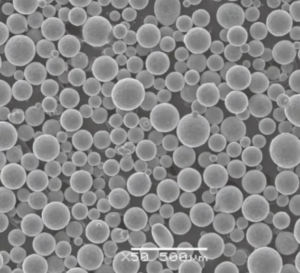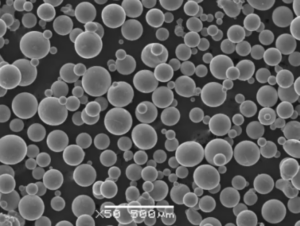Molybdän-Pulver ist ein vielseitiges Material mit einzigartigen Eigenschaften, die es ideal für verschiedene industrielle Anwendungen machen. Dieser Leitfaden bietet einen umfassenden Überblick über Molybdänpulver, einschließlich seiner Zusammensetzung, Eigenschaften, Herstellungsverfahren, Anwendungen und mehr.
Überblick über Molybdän-Pulver
Molybdänpulver ist eine Pulverform von Molybdänmetall. Es hat eine silbrig-weiße Farbe und besteht aus kleinen Molybdänpartikeln, die zwischen 1 und 100 Mikrometer groß sein können.
Zu den wichtigsten Eigenschaften, die Molybdänpulver auszeichnen, gehören:
- Hoher Schmelzpunkt von 2.623°C macht es feuerfest
- Hervorragende Wärmeleitfähigkeit zur Wärmeableitung
- Niedriger thermischer Ausdehnungskoeffizient zur Minimierung der Verformung
- Korrosionsbeständigkeit in sauren und alkalischen Umgebungen
- Fähigkeit, Gase wie Wasserstoff zu absorbieren
- Festigkeit und Härte auch bei hohen Temperaturen
Dank dieser nützlichen Eigenschaften kann Molybdänpulver Nischenfunktionen in der Elektronik, Chemie, Metallurgie, Glasindustrie und anderen Sektoren erfüllen.
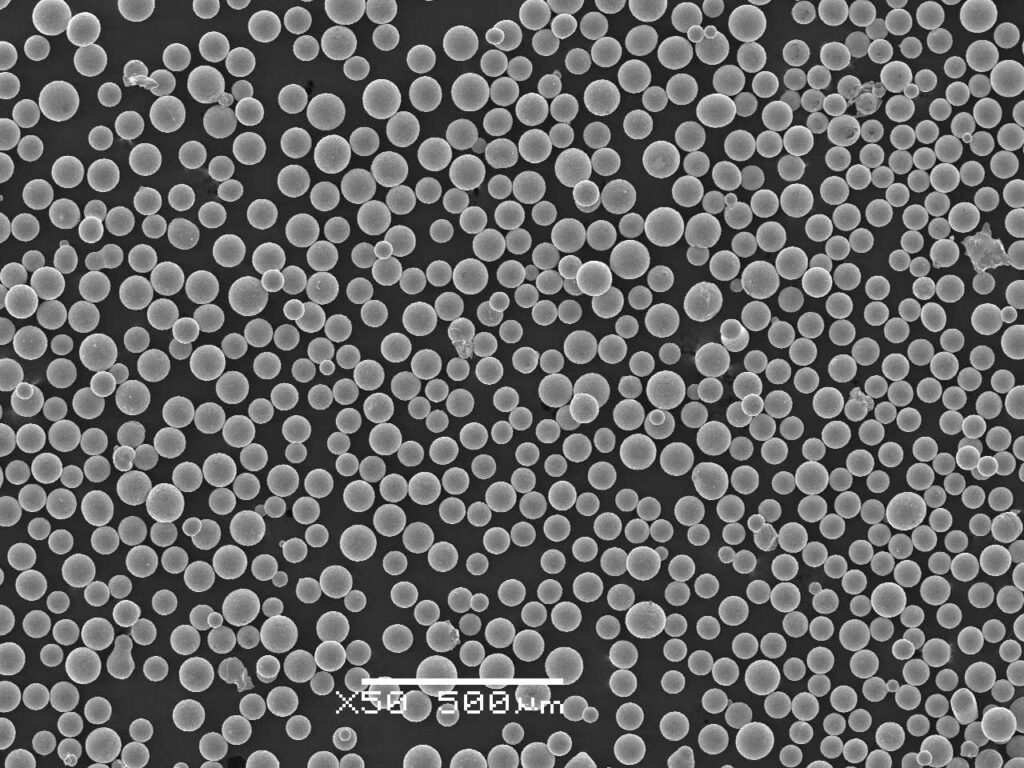
Zusammensetzung von Molybdän-Pulver
Kommerziell erhältliches Molybdänpulver enthält eine Mindestreinheit von 99 % Molybdän nach Gewicht. Die wichtigsten Verunreinigungen sind Spuren von Metallen wie Eisen, Nickel, Chrom und Silizium.
| Element | Zusammensetzung (%) |
|---|---|
| Molybdän | ≥ 99 |
| Sauerstoff | ≤ 0.05 |
| Stickstoff | ≤ 0.05 |
| Kohlenstoff | ≤ 0.01 |
| Silizium | ≤ 0.01 |
| Nickel | ≤ 0.004 |
| Chrom | ≤ 0.002 |
| Eisen | ≤ 0.002 |
Es werden auch hochreine Qualitäten mit einem Reinheitsgrad von über 99,9 % hergestellt. Diese weisen eine strengere Kontrolle der zulässigen Verunreinigungen auf, die auf die spezifischen Endanwendungen zugeschnitten sind.
Merkmale von Molybdän-Pulver
Molybdänpulver zeichnet sich durch einzigartige Leistungsmerkmale aus, die sich aus den inhärenten metallurgischen Eigenschaften von Molybdän ergeben.
Physikalische Eigenschaften
| Eigentum | Spezifikation |
|---|---|
| Farbe | Silber-weiß metallisch |
| Dichte | 10.22 g/cm<sup>3</sup> |
| Schmelzpunkt | 2,623°C |
| Wärmeleitfähigkeit | 138 W/(m-K) |
| Elektrischer Widerstand | 53 nΩ-m |
| Koeffizient der thermischen Ausdehnung | 4.8 μm/(m-K) |
Mechanische Eigenschaften
Als hochschmelzendes Metall behält Molybdän seine beeindruckende Festigkeit, Härte und Kriechbeständigkeit weit über den Arbeitsbereich herkömmlicher Metalle hinaus.
| Eigentum | Wert |
|---|---|
| Zugfestigkeit | 560 MPa |
| Streckgrenze | 470 MPa |
| Dehnung | 38% |
| Mikrohärte | 2.200 HV |
Reaktivität und Korrosionsbeständigkeit
Molybdän weist dank einer schützenden Oxidschicht eine ausgezeichnete Korrosionsbeständigkeit und chemische Verträglichkeit auf. Dadurch kann es stark sauren oder alkalischen Bedingungen widerstehen.
Unter 600°C oxidiert es nicht an der Luft. Aber oberhalb dieses Temperaturbereichs absorbiert es aktiv Sauerstoff, Schwefel- und Kohlenstoffverbindungen. Diese Fähigkeit zur Sauerstoffabsorption wird bei thermischen Verarbeitungsprozessen genutzt.
Insgesamt bietet Molybdän einen guten Schutz gegen Oxidations- und Zunderverschleißmechanismen.
Herstellungsverfahren für Molybdän-Pulver
Molybdänpulver wird kommerziell aus Molybdänerzen auf verschiedenen metallurgischen und pulverförmigen Wegen hergestellt.
1. Gewinnung aus Molybdänit-Erz
Molybdänit (MoS2) ist die einzige brauchbare Erzquelle für die Molybdänmetallproduktion. Konzentrate mit einem hohen MoS2-Gehalt von über 85 % werden geröstet oder unter Druck gelaugt, um Rohmolybdän als MoO3 zu gewinnen.
2. Reinigung auf technische Qualität
Verunreinigungen im rohen Molybdänoxid werden durch Sublimation oder chemische Behandlung entfernt. Auf diese Weise wird eine technische MoO3-Reinheit von etwa 99,95 % erzielt.
3. Wasserstoff-Reduktion
Das gereinigte MoO3 wird durch eine Reduktionsreaktion mit Wasserstoffgas bei 700-1100°C in Molybdänmetallpulver umgewandelt.
2 MoO3 + 3 H2 → 2 Mo + 3 H2O
Dieses Molybdän-Zwischenprodukt kann noch einige Sauerstoff- und Stickstoffverunreinigungen enthalten, die entfernt werden müssen.
4. Zusätzliche Veredelung
Bei hochreinen Sorten helfen zusätzliche Schritte wie das Elektronenstrahlschmelzen im Vakuum oder die thermische Desoxidation in Wasserstoffatmosphäre, um die gewünschte Chemie und Reinheit zu erreichen.
Das Pulver wird dann durch Zerkleinern, Mahlen und Sieben in spezifische Partikelgrößen unterteilt. Es kann auch in verschiedene gepresste und gesinterte Formen verdichtet werden.
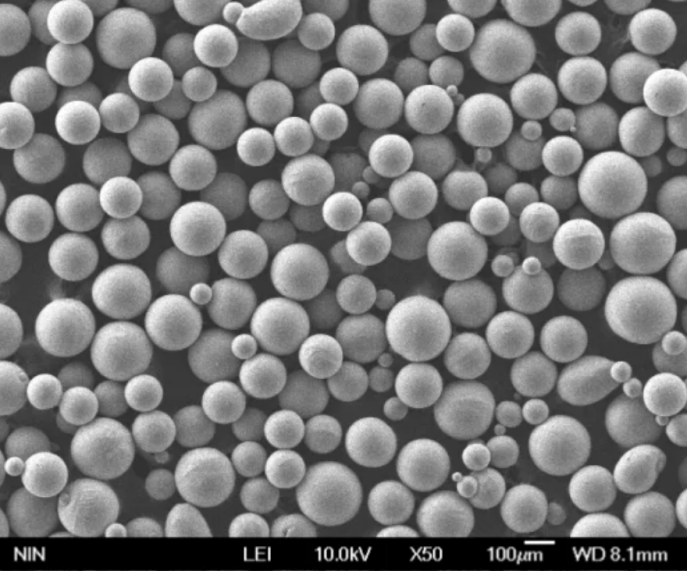
Anwendungen von Molybdän-Pulver
Filamente und Heizelemente
Molybdän ist aufgrund seiner feuerfesten Beschaffenheit, seiner thermischen Eigenschaften und seiner Oxidationsbeständigkeit ideal für Hochtemperatur-Heizelemente und Ofenkomponenten.
Am häufigsten wird es als Wickeldraht oder Heizdraht in Anwendungen wie:
- Elektrische Heizsysteme
- Hochintensive Entladungslampen (HID)
- Glasschmelzöfen
- Sputtertargets
- Vakuumröhrenelektroden
| Anmeldung | Betriebstemperaturen |
|---|---|
| Glasschmelze | 1400-1700°C |
| Diffusionsöfen | 1000-1400°C |
| Hochtemperaturöfen | Bis zu 2000°C |
Pulvermetallurgische Produkte
Molybdänpulver dient als Legierungszusatz zur Verbesserung der Warmfestigkeit, der Kriechfestigkeit, des Korrosionsschutzes und der thermischen Eigenschaften von Eisen- und Nickelsuperlegierungen.
Außerdem verbessert es die Sinterfähigkeit während des Flüssigphasensinterns. Zu den aus vorlegierten Mo-Pulvern hergestellten Teilen gehören:
- Turbinenmotor & Raketendüsen
- Ventilführungen
- Gesenke zum Warmschmieden
- Hüllen für Kernbrennstoffe
Keramischer Zusatzstoff
Molybdän bietet einen Oxidationsschutz für Graphitwerkzeuge, die bei der Bearbeitung von Siliziumwafern für die Chipherstellung verwendet werden.
Es wird auch in Molybdändisilicid-Heizelementen (MoSi2) verwendet, die bei Temperaturen jenseits der typischen Metalltemperaturen arbeiten.
Schmierstoff-Additiv
Organische Molybdänverbindungen wie Molybdändisulfid (MoS2) sind erstklassige Festschmierstoffe, die als reibungsmindernde und verschleißmindernde Additive eingesetzt werden. Sie bilden reibungsarme Filme, die bewegliche Schnittstellen selbst unter hohem Druck, im Vakuum oder bei Strahlung schützen.
Größen Normen und Qualitäten von Molybdänpulver
Molybdänpulver ist im Handel in einer breiten Palette von Partikelgrößen erhältlich, die meist zwischen 1 und 100 Mikron liegen:
Partikelgrößenverteilung
| Klasse | Maschenweite | Mikrometer |
|---|---|---|
| Grob | -100 Maschen | 149 Mikrometer maximal |
| Mittel | -325 Maschen | 44 Mikrometer maximal |
| Fein | -400 Maschen | maximal 38 Mikrometer |
| Sehr gut | -635 Maschen | max. 20 Mikrometer |
| Ultrafeine | -2500 Maschen | maximal 5 Mikrometer |
Die üblichen Spezifikationen gemäß ASTM-Normen sind:
Molybdän-Pulver-Sorten
| Klasse | Reinheit Mo % | Partikelgröße | Sauerstoff ppm |
|---|---|---|---|
| Klasse R | 99.5% | -325 Maschen | 700 |
| Note T | 99.7% | -325 Maschen | 700 |
| Note A | 99.9% | -325 Maschen | 100 |
| Note B | 99.95% | -635 Maschen | 10 |
| Raster C | 99.99% | -635 Maschen | 10 |
Bei hochreinen Sorten mit einem Reinheitsgrad von mehr als 99,95 % gelten strengere Kontaminationsgrenzwerte zur Kontrolle einzelner und aller metallischen Verunreinigungen.
Globale Hersteller & Lieferanten
Zu den wichtigsten Herstellern von Molybdänpulver weltweit gehören:
Wichtige Molybdänpulver-Hersteller
| Unternehmen | Standort |
|---|---|
| Freeport-McMoRan | USA |
| CXMET | China |
| Molibdenos y Metales S.A | Chile |
| China Molybdän Co, Ltd | China |
| JDC Molybdän Co. | China |
Preisgestaltung
Die Preise für Molybdänpulver schwanken je nach Marktdynamik und Reinheitsgrad. Richtige Preisspannen sind:
| Klasse | Preisspanne |
|---|---|
| 99% | $25 – $35 pro kg |
| 99.9% | $35 – $50 pro kg |
| 99.95% | $50 – $90 pro kg |
| 99.99% | $100 – $150 pro kg |
Wenden Sie sich an führende Molybdänpulver-Lieferanten, um aktuelle Preisangebote auf der Grundlage Ihrer angestrebten Reinheit, Partikelgrößenverteilung und Ihres jährlichen Mengenbedarfs zu erhalten.
Pro & Kontra von Molybdän-Pulver
Profis
- Hervorragende Festigkeit bei hohen Temperaturen
- Ausgezeichnete Korrosionsbeständigkeit
- Hohe Wärmeleitfähigkeit
- Kontrollierte Sauerstoffabsorptionsfähigkeit
- Legierungszusatz zur Verbesserung der Eigenschaften
- Erfüllt wichtige Funktionen, die nicht leicht zu ersetzen sind
Nachteile
- Spröde bei Raumtemperatur, die eine Legierung erfordert
- Anfällig für Versprödung durch Verunreinigungen
- Relativ selten und teuer
- Schwierige Verarbeitung in Pulverform
Vergleich mit Wolfram-Pulver
Sowohl Molybdän als auch Wolfram haben ähnliche feuerfeste Eigenschaften. Wolfram weist jedoch eine höhere Temperaturbeständigkeit in Bezug auf den Schmelzpunkt und die Rekristallisationstemperatur auf.
Molybdän bietet jedoch eine bessere elektrische und thermische Leitfähigkeit. Außerdem nimmt es bei hohen Temperaturen leichter Sauerstoff auf, während Wolfram relativ inert ist.
Dies verleiht Molybdän eine einzigartige Funktionalität für Anwendungen, bei denen eine kontrollierte Oxidation erforderlich ist. Außerdem ist Molybdän dadurch besser für die Pulververarbeitung geeignet.
Molybdän-Pulver vs. Wolfram-Pulver
| Parameter | Molybdän-Pulver | Wolframpulver |
|---|---|---|
| Schmelzpunkt | 2,623°C | 3,400°C |
| Dichte | 10.22 g/cc | 19.25 g/cc |
| Wärmeleitfähigkeit | 138 W/m-K | 173 W/m-K |
| Elektrischer Widerstand | 53 nΩ-m | 52 nΩ-m |
| Oxidationsbeständigkeit | Gut | Ausgezeichnet |
| Sauerstoffspülung | Hoch bei ≥ 600°C | Minimal |
| Typische Preisgestaltung | 25-150 $ pro kg | 20-50 Dollar pro kg |
Dies macht Molybdän- und Wolframpulver zu komplementären Materialien für Hochtemperaturanwendungen.
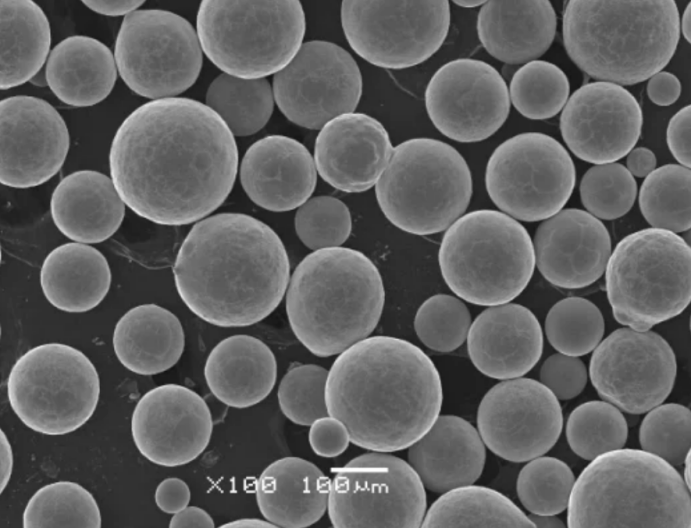
FAQ
Wozu wird Molybdänpulver verwendet?
Molybdänpulver wird als Heizdraht und Elektrode in Hochtemperaturöfen und Beleuchtungsanlagen, als pulvermetallurgischer Zusatzstoff zur Verbesserung der Warmfestigkeit und Korrosionsbeständigkeit von Legierungen, als Festschmierstoffzusatz und als Substrat für Elektronik und Optik verwendet.
Ist Molybdänpulver sicher in der Handhabung?
Wie die meisten pulverförmigen Metalle kann es bei wiederholter Exposition Reizungen oder Empfindlichkeit verursachen, insbesondere wenn es eingeatmet oder verschluckt wird. Bei der Lagerung und Handhabung sollten geeignete Vorsichtsmaßnahmen getroffen werden, einschließlich der Gewährleistung einer angemessenen Belüftung und eines Atemschutzes.
Was ist der Unterschied zwischen Molybdänpulver und Molybdändisulfid?
Molybdänpulver bezieht sich auf reines elementares Molybdän in Pulverform. Molybdändisulfid ist eine anorganische Verbindung, die nur Molybdän und Schwefel enthält. Es hat eine Schichtstruktur, die ihm Schmiereigenschaften und ein graphitähnliches Verhalten verleiht.
Was ist die typische Dichte von Molybdänpulver?
Die theoretische Dichte von reinem Molybdänpulver liegt bei etwa 10,22 g/cm. Im Handel erhältliche Pulver haben jedoch aufgrund von Faktoren wie Partikelgrößenverteilung und -form eine geringere Dichte von 70-90 %. Durch Druckverdichtung und Sintern lässt sich die Dichte des Pulvers auf bis zu 95 % der theoretischen Dichte erhöhen.
Ist Molybdänpulver ferromagnetisch oder paramagnetisch?
Molybdän ist ein paramagnetisches Metall, das heißt, es wird von magnetischen Kräften leicht angezogen. Es behält jedoch seine Magnetisierung nicht bei, wenn das Feld entfernt wird. Daher eignet es sich für Anwendungen, die im Vergleich zu ferritischen Legierungen nur minimalen Ferromagnetismus erfordern.
Schlussfolgerung
Mit seiner vielseitigen Mischung aus feuerfesten, leitfähigen, schützenden und schmierenden Eigenschaften bietet Molybdänpulver in verschiedenen Branchen Nischenfunktionen, die nicht einfach ersetzt werden können.
Es spielt eine wichtige Rolle in elektrischen Heizsystemen, Hochleistungslegierungen und Festschmierstoffadditiven, die die Grundlage der modernen Fertigungs-, Transport- und Verarbeitungsindustrie bilden.
Molybdänpulver ist zwar relativ teurer als sein Schwestermaterial Wolfram, doch die ständigen Fortschritte bei den Extraktionsverfahren und der Mangel an brauchbaren Alternativen sorgen dafür, dass Molybdänpulver dank seiner einzigartigen materialwissenschaftlichen Vorteile weiterhin eine starke Marktposition innehat.
